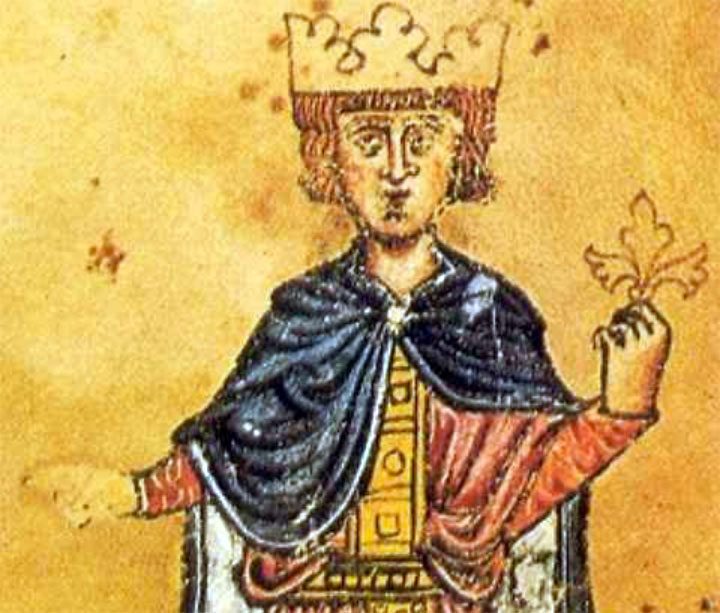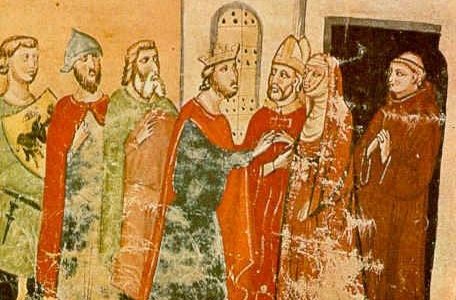{:it} Forse non tutti sanno ancora che Federico II di Svevia, Imperatore e Re di alcuni dei più grandi imperi del passato nacque in realtà nelle Marche, precisamente a Jesi, il 26 dicembre del 1194. Un collegamento fortuito che ha consacrato Jesi, consegnandola a tutte le enciclopedie e libri di storia. Proprio qui un museo porta il suo nome, in segno d’omaggio alla vita e all’opera del grande imperatore e mecenate che ha cambiato la storia.
Forse non tutti sanno ancora che Federico II di Svevia, Imperatore e Re di alcuni dei più grandi imperi del passato nacque in realtà nelle Marche, precisamente a Jesi, il 26 dicembre del 1194. Un collegamento fortuito che ha consacrato Jesi, consegnandola a tutte le enciclopedie e libri di storia. Proprio qui un museo porta il suo nome, in segno d’omaggio alla vita e all’opera del grande imperatore e mecenate che ha cambiato la storia.
Chi era Federico II e perché nacque a Jesi
Federico nacque a Jesi per caso, dove sua madre Costanza si era fermata mentre il marito era alle prese con la seconda (poi vittoriosa) spedizione per conquistare il Regno di Sicilia. Con la sua nascita furono riunite, in una sola persona, due delle più grandi casate europee dell’epoca: gli Svevi e gli Altavilla. Federico era perciò destinato a diventare un grande, ma fece in realtà molto di più, superando ogni aspettativa.
 Nato da un’unione fortunata e strategica, Federico era infatti figlio dell’Imperatore del Sacro Romano Impero, nonché Re di Germania e di Sicilia Enrico VI e di Costanza D’Altavilla. Erede del regno di Sicilia, Costanza ebbe un ruolo centrale nella guida dell’Impero e nell’andamento del futuro di suo figlio. Nel 1197, quando Enrico morì, Costanza portò avanti l’operato del marito e, per farlo, lasciò Federico nelle mani del nuovo Papa Innocenzo III, in qualità di tutore, garantendogli così non solo una brillante carriera ma la salvezza stessa.
Nato da un’unione fortunata e strategica, Federico era infatti figlio dell’Imperatore del Sacro Romano Impero, nonché Re di Germania e di Sicilia Enrico VI e di Costanza D’Altavilla. Erede del regno di Sicilia, Costanza ebbe un ruolo centrale nella guida dell’Impero e nell’andamento del futuro di suo figlio. Nel 1197, quando Enrico morì, Costanza portò avanti l’operato del marito e, per farlo, lasciò Federico nelle mani del nuovo Papa Innocenzo III, in qualità di tutore, garantendogli così non solo una brillante carriera ma la salvezza stessa.
Incoronato Re di Sicilia a soli 4 anni, e sempre sotto l’ala protettrice di papa Innocenzo III, Federico ricevette un’educazione poliedrica e completa, che non si soffermava solo su tematiche giuridiche e amministrative, ma che toccava anche le arti e la scrittura.
Federico fu, oltre ad un grande Re e Imperatore del Sacro Romano Impero, il fondatore della prima università pubblica e laica dell’occidente, a Napoli, e contribuì in modo sostanziale alla letteratura italiana come la intendiamo oggi, attraverso la costituzione di una scuola poetica siciliana, alla quale si deve la nascita del “sonetto”. Scrittore a sua volta, Federico ospitò numerosi artisti nella sua corte. Mecenate attento e generoso era anche un cacciatore e un abile stratega: tutto questo gli valse il celebre appellativo di Stupor Mundi (meraviglia del mondo).
Il Museo di Jesi
Jesi celebra il genio e la grandezza dell’imperatore Federico II con un museo unico nel suo genere, che ne rievoca la vita, la storia e i progetti: dalla nascita fino alla conquista dei regni, passando per la sua frequente attività in campo artistico e letterario. Proprio nello storico Palazzo Ghislieri, punto preciso della città nel quale si dice sia nato Federico, si possono ammirare installazioni, contenuti multimediali, manifatture e tanto altro distribuiti in ben 16 sale. Un personaggio marchigiano per destino che ha lasciato tracce indelebili del suo passaggio da Jesi al mondo intero.
Orari di apertura, costo dei biglietti e altre info riguardanti il museo su: https://www.federicosecondostupormundi.it/{:}{:en}
Probably not everyone knows that Frederick II of Swabia – emperor and king of some of the biggest empires of the past – was actually born on 26 December 1194 in the region Marche, precisely in Jesi. A casualty indeed, that appointed the city of Jesi to every encyclopedia and history book. A museum in Jesi is named after him, his birth city paid homage to the life and actions of the great emperor and patron who changed history.
Who was Frederick II and why he was born in Jesi
Frederick was born accidentally in Jesi, where his mother Constance settled down while her husband was fighting during the second (and victorious) invasion to conquer the Kingdom of Sicily. After his birth, two of the most important Houses at the time reunited under one single person: Swabia and Altavilla. Frederick’s destiny was to become important, but he actually made much more than expected.
He was born from a happy and strategic marriage: Frederick was the son of Henry VI – Emperor of the Holy Roman Empire, King of Germany and Sicily – and Constance of Altavilla. Heiress of the Kingdom of Sicily, Constance had a key role in guiding the Empire and her son’s future. In 1197, when Henry died, Constance took the powers following her husband’s policies, and to do so, she placed Frederick under the protection of the new Pope Innocent III, who became her son’s tutor granting him a brilliant career and safety as well.
He was crowned King of Sicily aged 4, and under the protection of Pope Innocent III, Frederick was raised and educated to law, administration, but also arts and writing.
Frederick was a great king and emperor of the Holy Roman Empire, and the funder of the first public and laical university in the western world, in Naples, and substantially contributed to Italian literature – as we mean it today – by the constitution of the Sicilian school of Poetry, whose scholars invented the “sonnet”. He was a writer himself, Frederick gathered many artists around his court. He was an attentive and generous patron; he was also a hunter and a clever strategist: because of all this, he was aptly named Stupor Mundi (splendor of the world).
Museum in Jesi
Jesi celebrates the genius and greatness of the emperor Frederick II with a one-of-a-kind museum that evokes his life, history and projects: from his birth to the conquest of kingdoms, through his frequent activities in the literary and artistic fields. In Palazzo Ghislieri – the specific place where Frederick was born – you can see installations, multimedia contents, manufactures and much more over 16 rooms. A celebrity of the region Marche for destiny, who left insoluble traces of his presence from Jesi to the whole world.
Opening hours, ticket prices and other information about the museum please visit: https://www.federicosecondostupormundi.it/{:}
